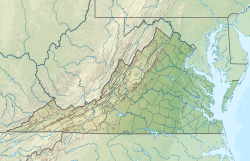Suffolk, Virginia | |
|---|---|
 A view of North Main Street in downtown Suffolk | |
 Interactive map of Suffolk | |
| Coordinates: 36°44′28″N 76°36′35″W / 36.74111°N 76.60972°W | |
| Country | United States |
| State | Virginia |
| County | None (Independent city) |
| Founded | 1742 |
| Area | |
| 428.91 sq mi (1,110.86 km2) | |
| • Land | 399.16 sq mi (1,033.82 km2) |
| • Water | 29.75 sq mi (77.05 km2) |
| Elevation | 39 ft (12 m) |
| Population (2020) | |
| 94,324 | |
| • Density | 220/sq mi (85/km2) |
| • Metro | 1,799,674 |
| Time zone | UTC−5 (EST) |
| • Summer (DST) | UTC−4 (EDT) |
| ZIP codes | 23432-23439 |
| Area codes | 757, 948 |
| FIPS code | 51-76432[2] |
| GNIS feature ID | 1500187[3] |
| Website | http://www.suffolkva.us/ |
Suffolk (locally /ˈsʌfʊk/ SUF-uuk) is an independent city in Virginia, United States. As of 2020, the population was 94,324.[4] It is the 10th-most populous city in Virginia, the largest city in Virginia by boundary land area as well as the 14th-largest in the country.[5] Suffolk is located in the Hampton Roads metropolitan area. This also includes the independent cities of Chesapeake, Hampton, Newport News, Norfolk, Portsmouth, and Virginia Beach, and smaller cities, counties, and towns of Hampton Roads. With miles of waterfront property on the Nansemond and James rivers, present-day Suffolk was formed in 1974 after consolidating with Nansemond County and the towns of Holland and Whaleyville. The current mayor (as of 2021) is Mike Duman.[6]
- ^ "2019 U.S. Gazetteer Files". United States Census Bureau. Retrieved August 7, 2020.
- ^ "U.S. Census website". United States Census Bureau. Retrieved January 31, 2008.
- ^ "US Board on Geographic Names". United States Geological Survey. October 25, 2007. Retrieved January 31, 2008.
- ^ "Suffolk population increases 5.1% in 26-month period; Check out your city's report". WTKR. July 4, 2023. Retrieved July 4, 2023.
- ^ "Suffolk has officially surpassed Portsmouth in population. But Hampton Roads as a whole is lagging in growth". The Virginian-Pilot. July 18, 2023. Retrieved July 18, 2023.
- ^ "Suffolk, Virginia". City of Suffolk, Virginia. Archived from the original on February 28, 2015. Retrieved August 30, 2014.


